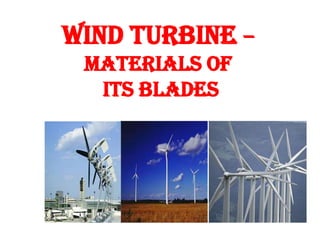
Materials Used for Wind Turbine Blades
- 1. Wind Turbine – Materials of its Blades
- 2. INTRODUCTION • Blade is one of the most important parts for a wind turbine system. • Blades are required to preserve an optimum cross section for aerodynamic efficiency to generate the maximum torque to drive the generators. • Possible materials for blades include PVC, wood, fiber glass, polyurethane reinforced with carbon nanotubes
- 3. PVC
- 4. PVC wind turbine blade are becoming more and more common for homemade domestic wind turbines. Advantage: • Light weight • Easy to install • Material is easy to obtain • Cheap • Easy to work with
- 5. Disadvantage: • Only applied in small wind turbines • Brittle • Weak after continued exposure to sun UV rays • Short life-span in strong winds the flexibility of the PVC blades is useful as it takes some of the energy out of the wind preventing the wind turbine generator form spinning too quickly and being damaged.
- 6. WOOD
- 7. • Advantages: Easy to make Low cost Good wood may increase the lifetime of the blades. • Disadvantages Over time things tend to hit the blades which in wood causes little nicks in the blades
- 9. • CNTs is a tougher and lighter material. Explanation:It is substantially lighter and eight times tougher and more durable than currrently used blade materials. • Carbon nanotubes (CNTs) rank among the strongest and stiffest materials. • Ica Manas-Zloczower (Professor of Macromolecular Science and Engineering) said that results of mechanical testing for the carbon nanotubes reinforced polyurethane show that this material outperforms the currently used resins for wind blades applications. • Due to their remarkable properties, carbon nanotubes (CNTs) are considered to be among the most promising candidates for the reinforcement of polymer matrices such as those used for wind turbines.
- 11. Fiberglass is a fiber reinforced polymer made of a plastic matrix reinforced by fine fibers of glass. Advantages: • provides a high tensile strength - helping manufacturers to achieve larger blades and higher energy output; • corrosion resistance ; • a shorter manufacturing time-a single mold can be built and used over and over again to produce many blades relatively quickly; • commercially available and affordable; • lightweight. Disadvantages: • easily breaking and cracking; • low quality.
- 13. • Advantages: commercially available, highly durable,strong, slightly lighter than PVC, not UV affected, long life compared to PVC or wood, recyclable, improved strength and rigidity, better sheer strength at mounting points • Disadvantages: relatively heavy, expensive
